Slash Christian Church 1729 to present Oldest Wood Church in VA: History
The History of Slash Church, built 1729 in St. Paul's Parish, Hanover County, VA and Parish Formation from 1600's to Present by D. A. Jones. historian Church Website: www.slashcc.org
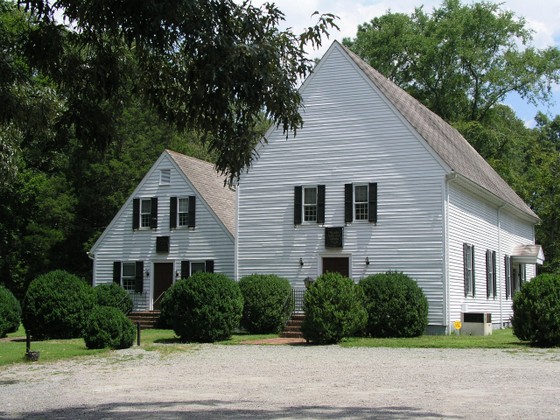
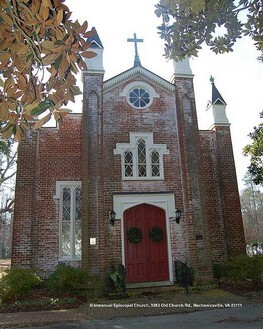 Immanual Episcopal Church, Mechanicsville, VA was our sister church - known as the Lower Church in the parish.
Immanual Episcopal Church, Mechanicsville, VA was our sister church - known as the Lower Church in the parish.
Slash Christian Church erected 1729 of wood cut from the property and attached smaller replica used as Sunday School built 1955. The current map image we have of Virginia was designated as Blissland Parish from the early settlement of the Church of England - Anglican. The settlers were given Land Grants that to us today would be enormous.
10203 Mount Hermon Rd., Ashland, VA 23005 / Office: 804-798-4520 / www.slashcc.org
1634 – 1728: There were eight original divisions of land – Shires/Parishes – in Va. set by the Colonial Government in Williamsburg which divided into named counties (government part) with Parish Identities (church part). We are descended from the Charles River Shire. The parish name for this large shire was Blisland or Blissland.(See top right hand illustration.) In 1654 New Kent County created from the Charles River/York shire and identified as St. Peter’s Parish 1679, was too large and was divided as follows: King & There Queen 1691, King William 1701-2, Hanover 1720-21. Louisa came from Hanover County in 1742. Hanover officially became solely identified as St. Paul’s Parish in 1704. (See Parish division illustration at right.) This too was divided into St. Martin’s Parish 1727 – western Hanover, Ashland Parish 1923, and Old Church Parish 1952. The community of Old Church however had been the Lower Parish church since 1679 and a new wood building was erected in 1718. The two wood buildings they constructed burned or fell into disrepair so they finally built the church pictured below of brick which serves them today.
Immanual Episcopal Church, Mechanicsville, VA 23111 see photo at left. See Historical Notes about this church 2nd paragraph.
 Immanual Episcopal Church, Mechanicsville, VA was our sister church - known as the Lower Church in the parish.
Immanual Episcopal Church, Mechanicsville, VA was our sister church - known as the Lower Church in the parish.Rectors served the entire parish area, riding to a different church each week. Parish congregations funded their rectors (pastors) by paying their saleries, providing them with servants, houses known as Glebes and any other ammenities as deemed necessary. In St. Paul's Parish, Slash Church was known as the Upper Church and Immanual Episcopal was known as the Lower Church. The salary was paid in Tobacco Receipts which was the currency at the time and determined by the Church of England. In the time frame we are talking about, Rectors were paid 16,000 pounds of Tobacco Receipts which required these two churches to join together to pay the Rector as neither could support him by themselves. If the tobacco growing had a bad year, the collected taxes would not be enough to pay the Rector. This actually happened: The Parsons' Cause Trial: 1763 right here at Hanover Courthouse, VA with our very own Patrick Henry as the attorney and his father John Henry (who was on the Vestry & became the sherrif) part of the trial. This was Patrick Henry's first legal case and he won for the people against the English (Anglican Church Kings & Queens were the heads of the church). This could have put Mr. Henry in jail for going against English rule but instead he became famous and later became the Gov. of VA. Please see the PDF above which you may read online or download and print.
The residents of each parish constructed the churches but the ownership belonged to the British Crown and the Colonial Government. Landowners also received their Grants of Land from England. Vestry records state, "Upon the petition of the upper inhabitants of this parish laying down that they are very remote from the church, it is ordered that a new church or chappell be built on the upper side of Mechumps Creeke adjoining the Kings road. Mr. John Kimburrow assuming to this Vestry that he will give two acres of land convenient to the said road and a spring and likewise all manner of timbers for building the said church…" This log church/chappell (20' x 40') was approximately one and a half miles north of the present Slash Church, near the present Hanover Station site, and served this parish until around 1730. Eventually, the " Mechumps Creek" church was boarded up and abandoned, possibly burned during the War Between the States. The Rev. Brook reported in 1724 to the Bishop of London that St. Paul's Parish was 12 miles wide and 60 miles long, encompassing 1200 families and 4 churches, with their congregations averaging between 200 and 300 individuals. These statistics indicated both the population growth and the resultant need for more churches.
1729: The Vestry of St. Paul's Parish convened June 16, 1729, offering to purchase three acres of land from the southeast corner of the farm of William Alsop, Jr., which farm had been conveyed July 9, 1724 by a 400 acre land grant along Stony Run, a branch of Mechumps Creeke. Mr. Alsop (see photo of his ancestor below) was paid 600 pounds of tobacco. This site was selected for a new church, because the land occupied a nice hill with a number of trees and included a spring with a bountiful supply of water. Just a month later, on July 17, 1729, the Vestry reconvened and authorized the construction of a large Upper Church about four miles from the present Hanover Courthouse (built 1735) area. “Saturday, July 19, 1729, gave the order to employ workmen to undertake and build a new church, and that publick notice be given thereof. Ordered that Mr. Thomas Pinchback and Mr. Edward Chambers, Jr. build a Church in the upper part of this parish sixty feet in length and twenty six foot in breadth; and sixteen foot in height in the Body from the Floor, of the Alley to the Ceiling; and that the Mr’s. Thomas Pinchback and Edward Chambers, do meet Cap. Wm. Fleming & Cap. Charles Hudson, on Saturday the Thirtieth of August next, at Col. David Meriwether’s, to enter in Articles with the said Fleming, and Hudson, concerning the said Church; and to give Bond and Security for the performance of the said Articles, the said Workmen to have for building the Said Church Sixty thousand pounds of Merchantable sweet Scented Tobacco with Cask, to be paid convenient in this parish, in two equal payments, the first to be paid November next, and the Other, the next November Following.” *St. Paul’s Vestry Book pg. 122-123. Payment actually was made Sept. 27, 1729 and Sept.16, 1730. At that time, only receipts for these transactions were tendered, these receipts being used in place of real currency and being the established practice of the era.
The topography of Pine Trees, sandy clay soil that drained poorly, numerous ravines/slashes, gave Slash its name. Construction was to be of wood cut from the property (southern Yellow Pine) mortised and fastened with wooden pegs. Windows and doorframes as well as doors are all hand wrought. There is no millwork in the entire structure. The roof is quite steeply pitched at 53 degrees. The roof supports consist of a main beam that runs diagonally rather than straight across the church, the vertical supports are in triangular form and there is no ridge beam. Some of the glass is original. Most of the wainscoting (of horizontal boards) is original, as are the stairway to the gallery, the gallery itself, which is a distinct architectural feature of churches of this period, and its balustrade and balusters. Two original pews remain in this gallery. The flooring in the nave succumbed to termites and was discovered after the fire in 1970. The architectural style is early Georgian, with typical nine over nine double-sash windows and exterior shutters, with deeply paneled double entrance doors. Exterior locks were replaced in 1954 with reproductions used in the 18th century.
The liturgical style of the building follows that of Greek temple design with three steps separating nave from chancel and the placement of the altar/communion table on the east wall. In 1953 - 1954, Lena Stafford Williams, church historian and mother of the pastor, Rev. George A. Williams, Jr., undertook an ambitious restoration project with help from the congregation to return the interior of the sanctuary to its initial appearance, insofar as could be ascertained. 19th century furnishings were replaced with reproductions of 18th century types. A central aisle replaced the double aisle configuration, wood-burning stoves and two chimneys were removed and the two upper windows on the west wall were repositioned (separated); paneled pews, lectern, pulpit, and altar were installed, along with paneled chairs for the clergy. On the east wall, behind the altar, the large wood panel containing The Lord's Prayer and the pair of wood flower brackets were placed. This covers over another window. Some of the 19th century sanctuary furnishings, which were removed during the restoration, are now preserved in the adjacent 1954 structure. Still in use for worship services is the early 19th century communion plate, consisting of silver flagon, chalice and paten. No other authentic items remain as Anglican valuables were sold back to the public.
The first rector of Slash Church was the Reverend Zachary Brook, who had first served Mechumps Creeke Church and served Slash until 1737, when the Rev. Patrick Henry (uncle of the famous orator) was called and served until his death in 1777. Slash was singled out especially by the Hanover Patriots who met before and after the revolution at Merrie Oaks Tavern nearby and at Hanover Courthouse and tavern there. During this time, the church became Protestant Episcopal but attendance dwindled and Slash, carrying a historical association with England, was abandoned. The congregation relocated their services to the Hanover Courthouse area. In 1840 St. Paul's Episcopal Church was built of brick but was destroyed by fire 1893, was rebuilt May 4, 1894 of wood, and continues in their use today. During this time of religious and governmental upheaval (1780-1785) Slash became a free for use church. Newly formed religious dissenters used Slash for their worship services. Although other protestant denominations used Slash for several years, the Methodists and the Disciples of Christ emerged as the principal users. In 1842, these two groups agreed that the Disciples would purchase the Slash building and property while the Methodists would buy nearby land, where they erected Lebanon Methodist Episcopal Church (Lebanon United Methodist). Their wood church was destroyed by fire in 1851 and was rebuilt about 1860. Siding covers the exterior and a new sanctuary has been erected. Current use plans for this old sister church sanctuary are undetermined. From their website: "Our story begins at least as early as 1828 when a Methodist Society held regular meetings in Slash Church, then shared by several denominations. In 1842 the Methodists thought it best to have a church building of their own and purchased one and one-half acres of land for the grand sum of $15. A house of worship was dedicated in 1844, but was destroyed by fire in 1851. The members then worshipped under a brush arbor until 1860 when the current historic sanctuary that we now know as the Chapel was erected."
Parish divisions of Hanover County VA
Map: Historic Hanover County © DAJones
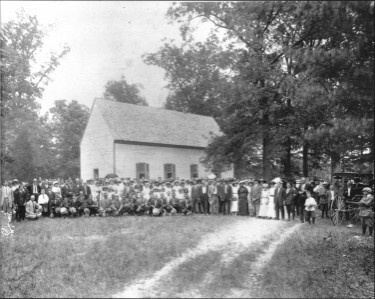
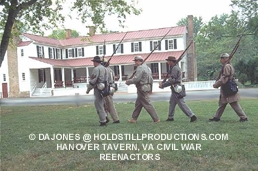
Shows the back of Slash Church w/attached Sunday School Building
and some of the Cemetary Plots - see Burial Records & Map for info.
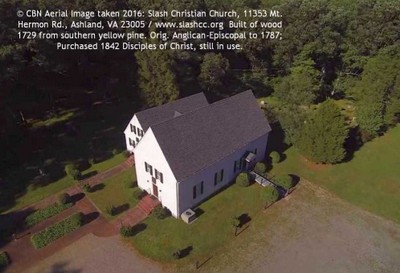
Aerial view of Slash Church 2016 taken by the Christian Broadcasting Network (CBN).
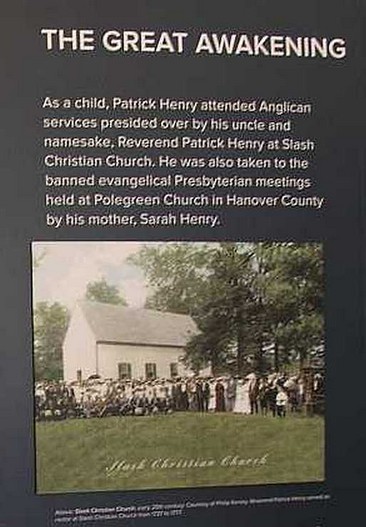
Display at Scotchtown of Kersey old photo of Slash Church w/association of The Great Awakening of the Protestant denominations other than Anglican Episcopal : w/Patrick Henry who later lived at Scotchtown for 6 yrs.
On May 26 & 27, 1862, Slash became the headquarters for Conf. Brig. Gen. L. OB Branch. Two battles in the vicinity on May 27, one on Mr. Kinney's land (the old Cross home), the other at Peake's Turnout (RR lines near Lebanon Church) resulted in a victory for the 12,000 Union forces vs. 4500 Confederate troops. Four local homes and Slash Church were used as hospitals for the over 300 wounded. Old trees cut at Slash around 1950's contained bullets from these battles. This encounter became known as the Battle of Slash Church in the South and the battle of Hanover Courthouse in the North. Book available www.michaelchardy.com. School was taught during the week - 1830's or 1840's.
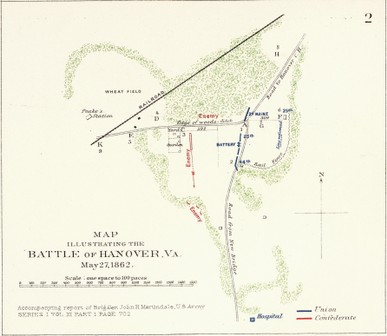
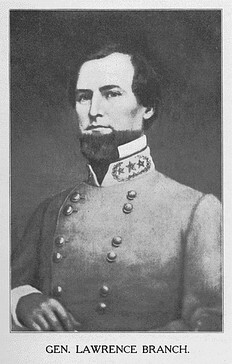

ANNIVERSARIES:
250th celebration 1979: Dressing in period style & other fun.

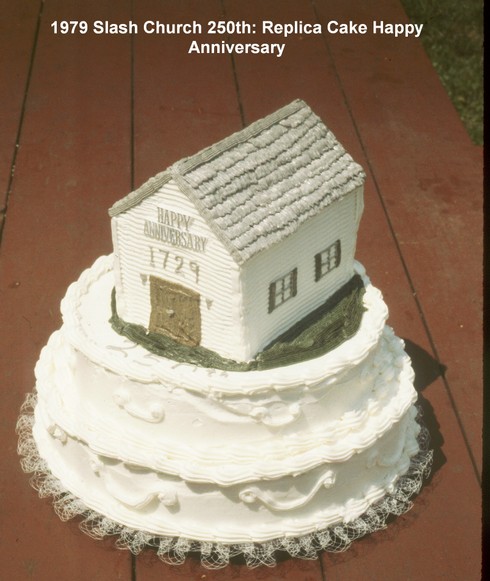

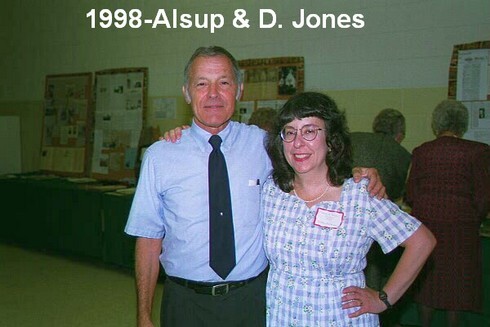
Mr Alsup is the ancestor of the owner who sold his land to the church in 1729.

Fork Episcopal Church 1735 brick St. Martin's Parish, Hanover County, VA
Near Scotchtown where Patrick Henry lived for 6 yrs.
